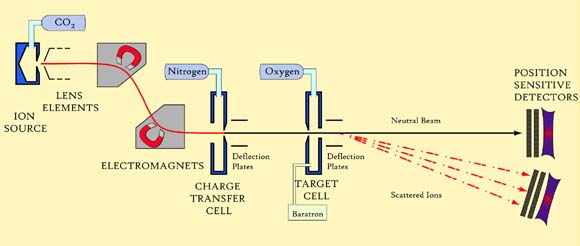|
|
The processes studied involve electron capture or electron
loss by a neutral projectile in collision with a gaseous target.
Examples include:
| O + H2
--> O+ + H2 + e- |
- Electron
loss (or stripping) |
|
|
| O + H2
--> O- + H2+ |
- Electron capture |
|
|
For charge transfer measurements, a single detector is adequate
because the primary ions can be deflected allowing the product
neutrals to be measured. However, for the capture and loss measurements,
two detectors are needed: one to measure the primary neutral
beam and a second to measure the charged products. The measurements
are more complex than those for charge transfer or direct scattering
because the two detectors must be calibrated relative to each
other.
| |
Electron-capture and -loss Apparatus
|
The schematic below represents the apparatus used to measures
capture and loss cross sections.

Schematic representation of the apparatus
- Ions are extracted from a low-pressure plasma-type ion source,
accelerated to the desired energy (0.5- 5keV) and focused by
an electrostatic lens.
- The ion beam is then mass-selected by a pair of 60 degree
sector magnets and passes through a charge transfer cell where
some of the ions are converted to neutrals.
- The neutral beam is then collimated by a pair of apertures
before traversing the target cell.
- A position-sensitive detector (PSD) on the beam axis approximately
68 cm beyond the target cell is used to monitor the primary neutral
beam.
- Positive or negative product ions are deflected through an
angle of approximately 5 degrees and detected with a second PSD.
- The pressure in the target cell (typically 10-30 mtorr) is
chosen to ensure that single collision conditions obtain.
- The relatively short target cell length, approximately 1
mm, ensures that the collisions occur within a very well defined
region and as the PSD records the position of each incident ion
the scattering angle is easily obtained.
- The number density of the target gas is obtained from a measurement
of the target gas pressure using a capacitance diaphragm gauge.
- Knowledge of the target cell length, the target number density,
the primary beam flux, and the flux and position of the scattered
ions allows us to determine the absolute differential and integral
electron transfer cross sections.
- For further details see Lindsay et al., Phys. Rev. A 70, 042701
(2004).
Physics
and Astronomy | Rice Quantum
Institute| Rice Space Institute
Rice University
Updated May 5, 2005
|

